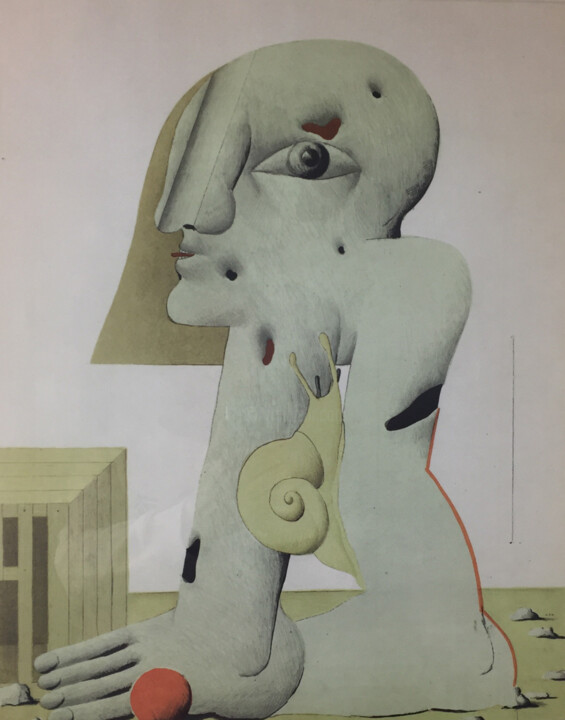Horst Antes
Horst Antes, born on October 28, 1936, in Heppenheim, Germany, is a celebrated painter, sculptor, and graphic artist whose innovative work has left an indelible mark on contemporary art. He is widely recognized for his unique style that combines figurative and abstract elements, marking significant contributions to the art world.
Antes's artistic journey began in the late 1950s when he studied under the influential artist HAP Grieshaber at the Academy of Fine Arts in Karlsruhe. During this period, he developed his signature artistic style, characterized by the iconic "Kopffüßler" (head-footers), a recurring figure in his work. These figures, distinguished by their large, often egg-shaped heads and truncated bodies, became a central motif in his paintings, drawings, and sculptures, embodying a unique blend of human and mythological elements.
At one point, Horst Antes was considered the most distinguished alumnus of Karlsruhe. As a student, he won the Hannover Grand Prix, held his first solo exhibition at age twenty-four, and was regarded as Germany's most influential post-war painter for many years.
In the 1960s, Antes received several scholarships and awards, including the Villa-Romana-Prize in Florence in 1962 and the Villa Massimo scholarship in Rome in 1963. At just 29, he accepted a teaching position at the Akademie in Karlsruhe, later serving as a professor there from 1967 to 1973 and as a guest professor at the Staatliche Hochschule für Bildende Künste in Berlin for one year. He resumed teaching at the Akademie in Karlsruhe in 1984, where he continued for another 16 years. In 1989, he was awarded the Hans-Molfenter-Prize by the regional capital.
 Horst Antes - Figure "Tête-Pied" à l'escargot. Lithography on Paper. 50 x 40 cm
Horst Antes - Figure "Tête-Pied" à l'escargot. Lithography on Paper. 50 x 40 cm
In his early works, Horst Antes sought a balance between figurative painting and L'Art Informel, drawing significant inspiration from Willem de Kooning. Around 1960, Antes developed his 'Kopffüßler' figures, a concept that he explored through various artistic techniques. By 1963, the 'Kopffüßler' had fully evolved in style and context, becoming a key element in his paintings and sculptures. In the 1970s, Antes began incorporating cardboard and rags into his canvases, adding texture and enhancing the enigmatic quality of his figures. As a forerunner of neo-expressionist figuration, he seemed to address the despair of the human condition in response to the dominance of abstract and conceptual art at the time.
In the early years of his career, Antes explored various artistic avenues, including painting, printmaking, and sculpture. His work often features bold colors and expressive forms, reflecting influences from Surrealism, Expressionism, and non-European art. He was particularly inspired by the early portraits of Renaissance painter Piero della Francesca and the ritual and everyday objects of North American Pueblo Indians, which he collected extensively.
Antes's work has been exhibited extensively in Europe and beyond, earning him a prominent place in the contemporary art world. He has participated in major exhibitions such as the Venice Biennale and Documenta in Kassel, showcasing his work alongside other leading artists of his time. His works are represented in all the most important German collections, et al. at the Kunsthall Hamburg, the Museum Ludwig in Cologne, the Nationalgalerie Berlin, and the Museum of Modern Art.
Horst Antes continues to live and work in Germany, where he remains a significant figure in the art community. His work is still celebrated for its distinctive blend of figurative and abstract elements and its deep exploration of human existence.
The iconic "Kopffüßler"
Horst Antes is perhaps best known for his iconic "Kopffüßler" figures, which have become a central motif in his paintings, drawings, and sculptures. The "Kopffüßler," or "head-footers," are characterized by their large, often egg-shaped heads and truncated bodies, representing a unique blend of human and mythological elements. These figures first appeared in the early 1960s and have since become synonymous with Antes's artistic style.
The "Kopffüßler" figures are often interpreted as representations of existential themes, exploring the complexities of human identity and experience. Through these simplified yet expressive forms, Antes delves into the emotional and psychological dimensions of the human condition. His use of bold colors and symbolic objects, such as cock's combs or letters, adds depth to the figures, inviting viewers to ponder the underlying narratives and emotions.
In addition to their symbolic significance, the "Kopffüßler" figures reflect Antes's interest in light and mood. He often depicts these figures in settings that evoke a sense of introspection and contemplation, with a focus on capturing the nuances of light and atmosphere. This approach has drawn comparisons to the work of artists like Willem de Kooning and other pioneers of new figurative painting.
Antes's "Kopffüßler" figures have been exhibited extensively in Europe and beyond, earning him a prominent place in the contemporary art world. His works are held in prestigious collections, including the Museum of Modern Art in New York and the Tate Gallery in London. The enduring appeal of the "Kopffüßler" lies in their ability to convey complex human emotions and experiences through a deceptively simple yet evocative form.
Horst Antes's legacy is defined by his contributions to both art and education, and his "Kopffüßler" figures continue to resonate with audiences worldwide. Through these iconic figures, Antes offers a profound exploration of human identity, emotion, and the existential aspects of life, securing his place as a pivotal figure in the history of modern art.


 Selena Mattei
Selena Mattei

